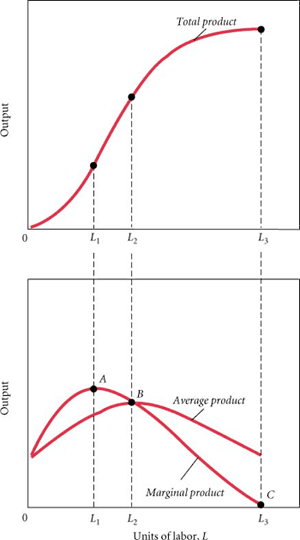Aggregate Production
The aggregate production function examines how productivity, or real GDP per worker, depends on the quantities of physical capital per worker and human capital per worker. The production function relates the physical outputs of production to the physical inputs or factors of production. The aggregate production takes the physical outputs and inputs into account to determine the allocative efficiency of the economy as a whole.
Aggregate production functions create an estimated framework to determine how much of an economy's growth is related to changes in capital or changes in technology. Production functions assume that the maximum output is attainable from a given set on inputs. The aggregate production function describes the boundary representing the limit of output attainable from each feasible combination of input.
To understand how the aggregate production impacts long-run growth, it is important to understand the stages of production :

Graphing Production
The production function of a firm or economy can be graphed using the total, average, and marginal products. The aggregate production is determined based on the stages of production and the results of the graph.
- Stage 1: the variable input is being used with increasing output per unit. The average physical product is at its maximum.
- Stage 2: output increases at a decreasing rate and the average and marginal physical product are declining. The average product of fixed inputs are still rising. The optimum input/output combination will be reached.
- Stage 3: variable input is too high relative to the available fixed inputs. The output of both fixed and variable input declines.
Aggregate Production and Long-Run Growth
The long-run growth of a firm can change the scale of operations by adjusting the level of inputs that are fixed in the short-run, which shifts the production function upward as plotted against the variable input. Aggregate production functions study the short-run inputs and outputs of a firm or economy. The results allow adjustments to be made which improves the long-run growth by balancing the inputs and outputs.